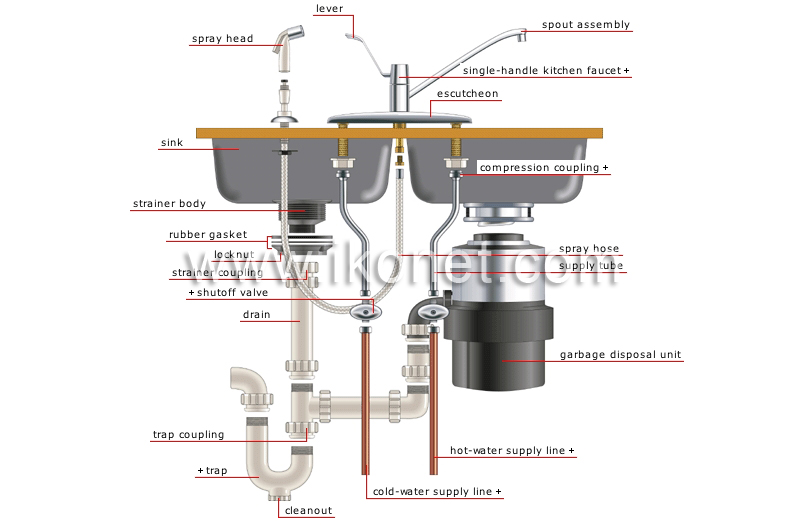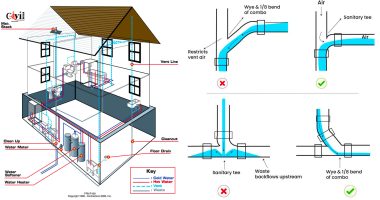A Guide to Your Property's Plumbing System Anatomy
A Guide to Your Property's Plumbing System Anatomy
Blog Article
Here in the next paragraphs you can discover some decent material about The Inner Workings of Your Home's Plumbing.

Recognizing exactly how your home's pipes system functions is necessary for every single homeowner. From delivering tidy water for alcohol consumption, food preparation, and bathing to securely removing wastewater, a well-kept pipes system is critical for your family's health and wellness and convenience. In this comprehensive overview, we'll explore the intricate network that comprises your home's pipes and deal tips on maintenance, upgrades, and handling common problems.
Intro
Your home's pipes system is more than just a network of pipes; it's a complicated system that guarantees you have access to tidy water and reliable wastewater removal. Knowing its elements and exactly how they interact can aid you prevent costly repair work and make sure everything runs smoothly.
Fundamental Parts of a Pipes System
Pipelines and Tubes
At the heart of your pipes system are the pipelines and tubes that lug water throughout your home. These can be constructed from various materials such as copper, PVC, or PEX, each with its benefits in terms of toughness and cost-effectiveness.
Components: Sinks, Toilets, Showers, and so on.
Fixtures like sinks, toilets, showers, and tubs are where water is made use of in your house. Recognizing exactly how these components link to the plumbing system assists in identifying issues and preparing upgrades.
Valves and Shut-off Points
Valves control the flow of water in your plumbing system. Shut-off shutoffs are crucial throughout emergency situations or when you require to make fixings, permitting you to separate parts of the system without interrupting water flow to the entire residence.
Water System
Main Water Line
The primary water line connects your home to the municipal water supply or a private well. It's where water enters your home and is distributed to various fixtures.
Water Meter and Stress Regulatory Authority
The water meter procedures your water use, while a pressure regulator makes certain that water moves at a risk-free pressure throughout your home's plumbing system, preventing damage to pipes and components.
Cold Water vs. Warm water Lines
Comprehending the distinction between cold water lines, which provide water straight from the main, and warm water lines, which lug heated water from the water heater, aids in repairing and planning for upgrades.
Drainage System
Drain Pipes Water Lines and Traps
Drain pipes carry wastewater far from sinks, showers, and bathrooms to the sewer or septic system. Catches avoid sewer gases from entering your home and additionally catch debris that can trigger clogs.
Air flow Pipes
Air flow pipelines enable air into the drainage system, protecting against suction that can slow down drain and trigger catches to empty. Correct ventilation is important for maintaining the stability of your plumbing system.
Significance of Correct Drain
Ensuring correct drainage prevents backups and water damages. Frequently cleaning drains pipes and maintaining catches can prevent pricey repair work and expand the life of your plumbing system.
Water Furnace
Types of Hot Water Heater
Water heaters can be tankless or typical tank-style. Tankless heaters warm water as needed, while tanks save heated water for instant usage.
Exactly How Water Heaters Attach to the Plumbing System
Recognizing how water heaters attach to both the cold water supply and hot water circulation lines helps in identifying concerns like insufficient warm water or leakages.
Maintenance Tips for Water Heaters
On a regular basis purging your water heater to eliminate debris, inspecting the temperature level settings, and examining for leakages can extend its life-span and enhance power efficiency.
Usual Plumbing Problems
Leaks and Their Reasons
Leaks can occur because of maturing pipelines, loose fittings, or high water stress. Addressing leaks immediately protects against water damage and mold growth.
Obstructions and Clogs
Clogs in drains and bathrooms are commonly brought on by flushing non-flushable items or an accumulation of oil and hair. Making use of drainpipe screens and bearing in mind what goes down your drains can avoid obstructions.
Signs of Plumbing Troubles to Watch For
Low water stress, sluggish drains pipes, foul odors, or abnormally high water costs are signs of potential plumbing issues that ought to be attended to without delay.
Pipes Upkeep Tips
Normal Inspections and Checks
Schedule annual plumbing inspections to catch issues early. Search for indications of leaks, rust, or mineral accumulation in faucets and showerheads.
DIY Maintenance Tasks
Easy tasks like cleaning faucet aerators, checking for toilet leaks using dye tablet computers, or shielding revealed pipelines in cool environments can avoid major plumbing problems.
When to Call a Specialist Plumbing Professional
Know when a pipes concern requires professional knowledge. Trying complicated repair work without proper understanding can cause more damage and greater fixing expenses.
Upgrading Your Pipes System
Factors for Updating
Updating to water-efficient components or changing old pipelines can boost water top quality, minimize water expenses, and boost the value of your home.
Modern Plumbing Technologies and Their Benefits
Check out innovations like smart leak detectors, water-saving toilets, and energy-efficient water heaters that can conserve cash and lower ecological influence.
Price Factors To Consider and ROI
Compute the in advance expenses versus long-lasting cost savings when considering plumbing upgrades. Many upgrades spend for themselves via lowered energy expenses and fewer repair work.
Environmental Impact and Preservation
Water-Saving Components and Home Appliances
Setting up low-flow faucets, showerheads, and toilets can significantly lower water use without compromising performance.
Tips for Lowering Water Usage
Easy routines like fixing leakages quickly, taking much shorter showers, and running full loads of washing and dishes can preserve water and lower your energy bills.
Eco-Friendly Pipes Options
Consider lasting plumbing products like bamboo for flooring, which is durable and green, or recycled glass for countertops.
Emergency Readiness
Steps to Take Throughout a Plumbing Emergency situation
Know where your shut-off valves lie and how to shut off the water supply in case of a ruptured pipeline or major leakage.
Significance of Having Emergency Calls Useful
Keep call information for regional plumbers or emergency services easily offered for fast reaction throughout a plumbing situation.
DIY Emergency Fixes (When Suitable).
Temporary solutions like using air duct tape to patch a dripping pipe or positioning a bucket under a trickling faucet can decrease damage till a professional plumbing professional shows up.
Verdict.
Recognizing the composition of your home's plumbing system equips you to preserve it properly, saving time and money on repair services. By adhering to normal maintenance routines and remaining notified concerning modern plumbing innovations, you can guarantee your pipes system operates efficiently for many years to come.
HOW YOUR PLUMBING SYSTEM WORKS
Which Pipes Do What?
Blue lines = fresh water supply entering the building
Red lines = hot water supply entering the building
Grey lines = pipes carrying waste away from the building and venting pipes carrying gases away from the building (through the roof)
YOUR MAIN PLUMBING SYSTEMS
There are two main plumbing systems that support your home s basic plumbing needs one that brings clean water into your home, and one that sends dirty water away from your home. Connected to the toilet, bath, shower, and other faucets in your home, these two systems keep your water flowing in the right directions.
ACCESSING FRESH WATER
Fresh and clean water is brought into your home through the main water supply line . Filtered through one pipe, this water is pressured to flow into the various fixtures in your home at any given time.
This water can be sourced from a well located on your property, a pond or river (mostly cottages), or, as in most cases, from the city s municipal water treatment centre. However, it is important to note that water that is untreated, such as the water siphoned from ponds or rivers, may not be safe to drink. Personal water supplies always need to be treated for hardness and contaminants before consumed.
MUNICIPAL WATER SUPPLIES
Improve taste and odour
Remove sediment
Eliminate hardness
Reduce chlorine
COLD WATER SUPPLY VS. HOT WATER SUPPLY
Cold water flows into your home or building through the service line, which then distributes hot or cold water to your fixtures. This line is most commonly run through a central column that runs floor to floor. Hot water runs in short and straight pipes as the longer the pipeline, the more heat that will be lost in the transfer. Having shorter pipes also allows residents to access hot water more quickly.
WASTE WATER SYSTEM
Your wastewater system is divided into two parts pipes that send wastewater away from your home and venting pipes that send sewer gas away from your home. Sewage water travels through pipes that flush the water and waste towards local sewers that are operated and managed by your city or town. Most sewer systems rely on gravity to move the wastewater to where it needs to go.
The further away from your toilet or sink, the larger wastewater pipes become. This allows for waste to be disposed of from various parts of your home or business at once without pipe blockages. The angle and flow of these pipes are also essential for keeping your waste pipes clear of build up.
https://harrisplumbing.ca/how-your-home-plumbing-system-works/

HOW YOUR PLUMBING SYSTEM WORKS
Which Pipes Do What?
YOUR MAIN PLUMBING SYSTEMS
There are two main plumbing systems that support your home s basic plumbing needs one that brings clean water into your home, and one that sends dirty water away from your home. Connected to the toilet, bath, shower, and other faucets in your home, these two systems keep your water flowing in the right directions.
ACCESSING FRESH WATER
Fresh and clean water is brought into your home through the main water supply line . Filtered through one pipe, this water is pressured to flow into the various fixtures in your home at any given time.
This water can be sourced from a well located on your property, a pond or river (mostly cottages), or, as in most cases, from the city s municipal water treatment centre. However, it is important to note that water that is untreated, such as the water siphoned from ponds or rivers, may not be safe to drink. Personal water supplies always need to be treated for hardness and contaminants before consumed.
MUNICIPAL WATER SUPPLIES
COLD WATER SUPPLY VS. HOT WATER SUPPLY
Cold water flows into your home or building through the service line, which then distributes hot or cold water to your fixtures. This line is most commonly run through a central column that runs floor to floor. Hot water runs in short and straight pipes as the longer the pipeline, the more heat that will be lost in the transfer. Having shorter pipes also allows residents to access hot water more quickly.
WASTE WATER SYSTEM
Your wastewater system is divided into two parts pipes that send wastewater away from your home and venting pipes that send sewer gas away from your home. Sewage water travels through pipes that flush the water and waste towards local sewers that are operated and managed by your city or town. Most sewer systems rely on gravity to move the wastewater to where it needs to go.
The further away from your toilet or sink, the larger wastewater pipes become. This allows for waste to be disposed of from various parts of your home or business at once without pipe blockages. The angle and flow of these pipes are also essential for keeping your waste pipes clear of build up.
https://harrisplumbing.ca/how-your-home-plumbing-system-works/
I ran across that write up about The Inner Workings of Your Home's Plumbing while doing a search on the internet. Enjoyed our post? Please share it. Help other people locate it. Thank you so much for your time invested reading it.
Go Company Report this page